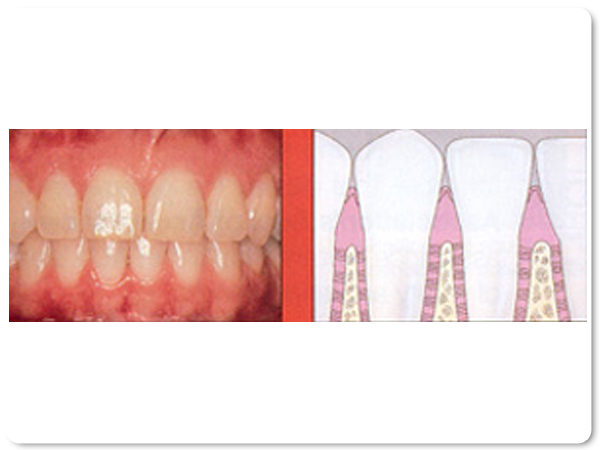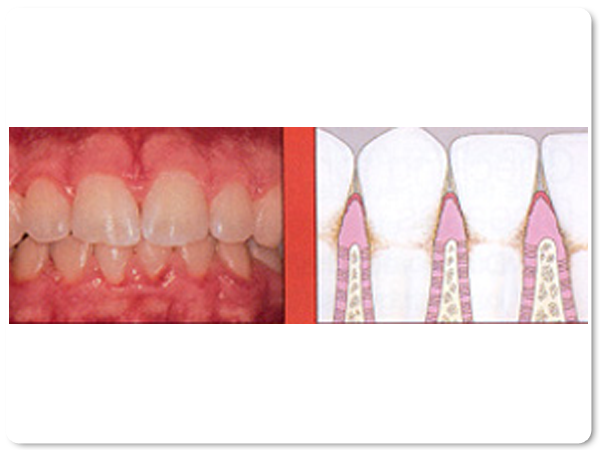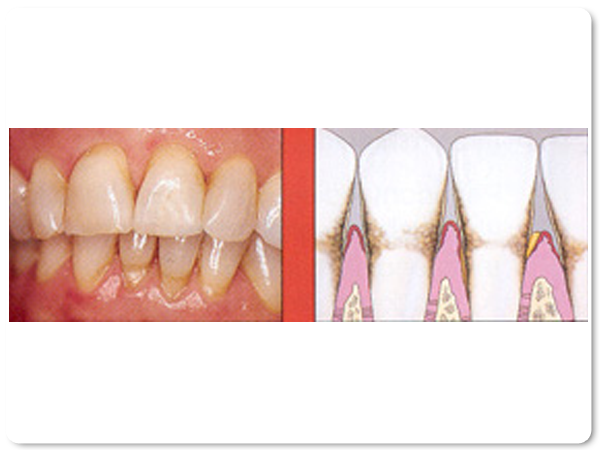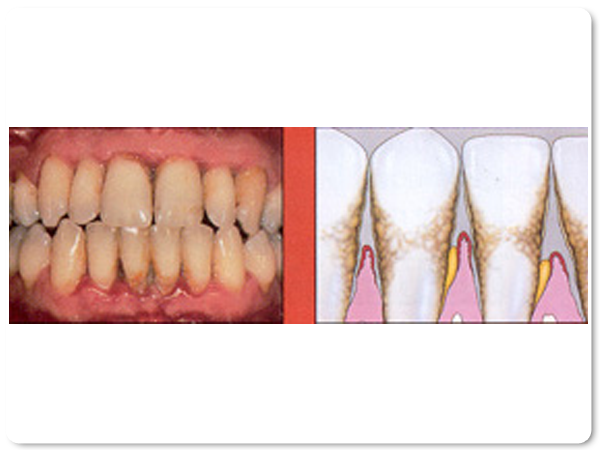Gum Disease
What is gum disease?
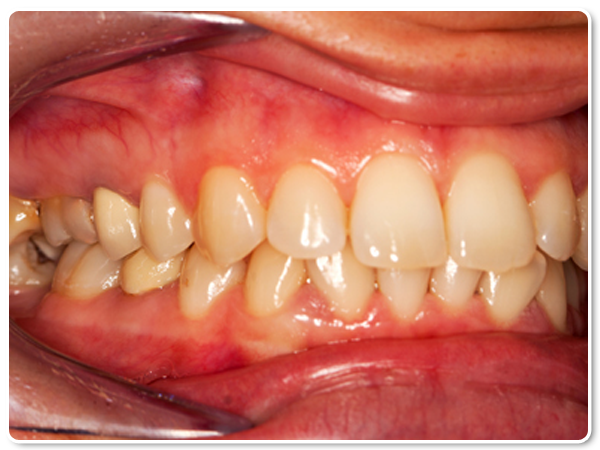
Gum disease or periodontal disease, chronic inflammation, and infection of the gums and surrounding tissue is the major cause of about 70 percent of adult tooth loss, affecting three out of four persons at some point in their life.
What causes gum disease?
Bacterial plaque – a sticky, colorless film that constantly forms on the teeth – is recognized as the primary cause of gum disease. Specific periodontal diseases may be associated with specific bacterial types. If plaque isn’t removed each day by brushing and flossing, it hardens into a rough, porous substance called calculus (also known as tartar). Toxins (poisons) produced and released by bacteria in plaque irritate the gums. These toxins cause the breakdown of the fibers that hold the gums tightly to the teeth, creating periodontal pockets which fill with even more toxins and bacteria. As the disease progresses, pockets extend deeper and the bacteria moves down until the bone that holds the tooth in place is destroyed. The tooth eventually will fall out or require extraction.
Are there other factors?
Yes. Genetics is also a factor, as are lifestyle choices. A diet low in nutrients can diminish the body’s ability to fight infection. Smokers and spit tobacco users have more irritation to gum tissues than non-tobacco users, while stress can also affect the ability to ward off disease. Diseases that interfere with the body’s immune system, such as leukemia and AIDS, may worsen the condition of the gums. In patients with uncontrolled diabetes, where the body is more prone to infection, gum disease is more severe or harder to control.
What are the warning signs of gum disease?
This photo shows healthy gums in light pink color and teeth are free of tartar. Also, the gums and bones are at a healthy level.
Tartar has begun to develop on the teeth. The bacteria in the tartar release toxins causing irritation to gums. Gums become swollen, and tender, and bleed easily. This condition is called gingivitis where the gums are inflamed but the bone is at a healthy level.
As the tartar builds up gradually, the toxins & enzymes from the bacteria then start to destroy the bone around the tooth. As a result, the bone level reduces depending on the extent to which the bone is affected. This condition is called mild or moderate periodontitis.
With heavy tartar buildup, bone loss increases. This reduces the support for the teeth. They become loose and may tend to shift in position. This advanced periodontitis leads to loss of teeth unless intervened by extensive treatment.
Signs include red, swollen or tender gums, bleeding while brushing or flossing, gums that pull away from teeth, loose or separating teeth, puss between the gum and tooth, persistent bad breath, change in the way teeth fit together when the patient bites, and a change in the fit of partial dentures. While patients are advised to check for the warning signs, there might not be any discomfort until the disease has spread to a point where the tooth is unsalvageable. That’s why patients are advised to get frequent dental exams.
What does periodontal treatment involve?
In the early stages, most treatment involves scaling and root planing-removing plaque and calculus around the tooth and smoothing the root surfaces. Antibiotics or antimicrobials may be used to supplement the effects of scaling and root planing. In most cases of early gum disease, called gingivitis, scaling and root planing and proper daily cleaning achieve a satisfactory result. More advanced cases may require surgical treatment, which involves cutting the gums, and removing the hardened plaque build-up and recontouring the damaged bone. The procedure is also designed to smooth root surfaces and reposition the gum tissue so it will be easier to keep clean.
How do you prevent gum disease?
Removing plaque through daily brushing, flossing and professional cleaning is the best way to minimize your risk. Your dentist can design a personalized program of home oral care to meet your needs. If a dentist doesn’t do a periodontal exam during a regular visit, the patient should request it. Children also should be examined.
What is the role of the general dentist?
The general dentist usually detects gum disease and treats it in the early stages. Some general dentists have acquired additional expertise to treat more advanced conditions of the disease. If the general dentist believes that the gum disease requires treatment by a specialist, the patient will be referred to a periodontist. The dentist and periodontist will work together to formulate a treatment plan for the patient.
Is maintenance important?
Sticking to a regular oral hygiene regimen is crucial for patients who want to sustain the results of therapy. Patients should visit the dentist every 3-4 months (or more, depending on the patient) for spot scaling and root planning and an overall exam. In between visits, they should brush at least twice a day, floss daily, and brush their tongue. Manual soft nylon bristle brushes are the most dependable and least expensive. Electric brushes are also a good option, but don’t reach any further into the pocket than manual brushes. Proxy brushes (small, narrow brushes) are the best way to clean in between the recesses in the teeth, and should be used once a day. Wooden tooth picks and rubber tips should only be used if recommended by your dentist.











 My husband and I love Prestonwood Dental. I already wrote a review for Dr. Daftary, and realized I should write one for her practice as well, because she and her entire team are brilliant
My husband and I love Prestonwood Dental. I already wrote a review for Dr. Daftary, and realized I should write one for her practice as well, because she and her entire team are brilliant

